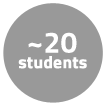Instructor Insights pages are part of the OCW Educator initiative, which seeks to enhance the value of OCW for educators.
Course Overview
This page focuses on the course 9.04 Sensory Systems as it was taught by Professors Peter H. Schiller and Chris Brown in Fall 2013.
This course examines the neural bases of visual and auditory processing for perception and sensorimotor control, focusing on physiological and anatomical studies of the mammalian nervous system as well as behavioral studies of animals and humans. The course features a discussion of cochlear implants led by an implant user and a tour of the Massachusetts Eye and Ear Infirmary (MEEI).
Course Outcomes
Course Goals for Students
The goal of the course was for students to obtain a thorough understanding of the concepts outlined in the course overview. Students acquired an extensive vocabulary of terms describing anatomy and physiology for both systems. One skill acquired during the course was for students to be able to read original research reports that covered recent findings in vision and audition. A final goal was to be able to compare visual and auditory processing in the respective centers of the brain.
Possibilities for Further Study/Careers
Most of these students go on to graduate school in some aspect of neuroscience or to medical school.
Curriculum Information
Prerequisites
9.01 Introduction to Neuroscience or permission of the instructor.
Requirements Satisfied
9.04 can be applied toward a Bachelor of Science in Brain and Cognitive Sciences, but is not required.
Offered
Every other fall semester.
Instructor Insights
Below, Profs. Schiller and Brown describe various aspects of how they taught 9.04 Sensory Systems.
The demonstration by a user of a cochlear implant helps a great deal to convince students that this prosthesis for deaf individuals is a success but that it also has limitations.
— Profs. Schiller and Brown
- There are large amounts of scientific knowledge on vision and audition. We tried to survey what is known but necessarily were only able to skim the surface.
- We prepared for class by examining the new literature in order to decide which new readings to incorporate into the class.
- In our teaching, we tended to incorporate more and more examples for medical applications. For example, the demonstration by a user of a cochlear implant helps a great deal to convince students that this prosthesis for deaf individuals is a success but that it also has limitations.
- One way the course has changed over the past 15 years is that originally each student presented an oral report on a research paper. When the attendance of the class increased, these presentations were dropped due to time constraints.

Breakdown by Year
Roughly 1/4 juniors and 3/4 seniors.
Breakdown by Major
Primarily Brain and Cognitive Science majors, with some dual majors in another subject.
During an average week, students were expected to spend 12 hours on the course, roughly divided as follows:
Lecture
- Met 2 times per week for 1.5 hours per session; 26 sessions total; mandatory attendance.
- Lectures highlighted and emphasized the major concepts and presented relevant examples from medical problems of interest to students. There was time for questions during the lecture and especially at the conclusion of the classes. A brief description of the readings was incorporated in the lecture, usually toward the end of each lecture.
- The first class meeting was a general introduction to the course. Subsequently, the first half of the semester was devoted to the visual system and the second half of the semester was devoted to the auditory system.
- Three lectures were dedicated to review and questions, one before the midterm exam and two before the final exam.
- One auditory system lecture included a discussion with an MIT undergraduate student who is a cochlear implant user.
- Students took 2 exams with multiple choice and short answer questions.
- Toward the end of the semester, a tour of a hearing research laboratory was offered (not taped for OCW) at MEEI.
Out of class
- Each lecture had associated readings, many of which were original research reports, to be completed in advance of the lecture.
- Students were able to contact the professors if additional meetings were necessary to understand the material or to go over exams. At the end of the semester, two class periods were devoted to review and questions.
- Student completed 2 written assignments based on literature and concepts covered in class with questions devoted to exploring particular ideas in depth.
Semester Breakdown
| WEEK | M | T | W | Th | F |
|---|---|---|---|---|---|
| 1 |  |  |  |  |  |
| 2 |  |  |  |  |  |
| 3 |  |  |  |  |  |
| 4 |  |  |  |  |  |
| 5 |  |  |  |  |  |
| 6 |  |  |  |  |  |
| 7 |  |  |  |  |  |
| 8 |  |  |  |  |  |
| 9 |  |  |  |  |  |
| 10 |  |  |  |  |  |
| 11 |  |  |  |  |  |
| 12 |  |  |  |  |  |
| 13 |  |  |  |  |  |
| 14 |  |  |  |  |  |
| 15 |  |  |  |  |  |
| 16 |  |  |  |  |  |
 No classes throughout MIT
No classes throughout MIT Visual system lecture
Visual system lecture Intro or review lecture
Intro or review lecture Tour of MEEI
Tour of MEEI No class session scheduled
No class session scheduled Auditory system lecture
Auditory system lecture Guest lecturer
Guest lecturer Written assignment or exam
Written assignment or exam